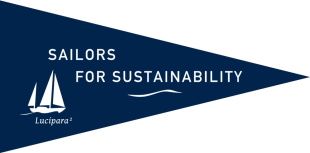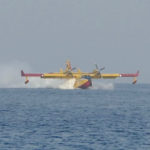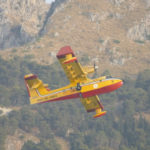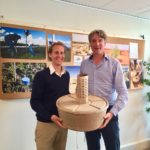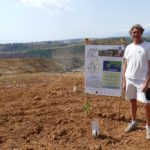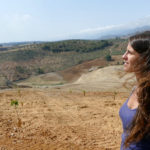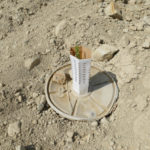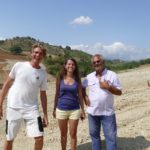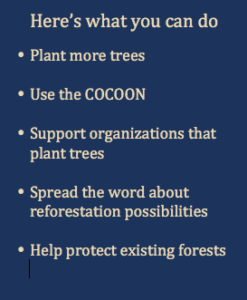Reforestation on Steroids (ITA)
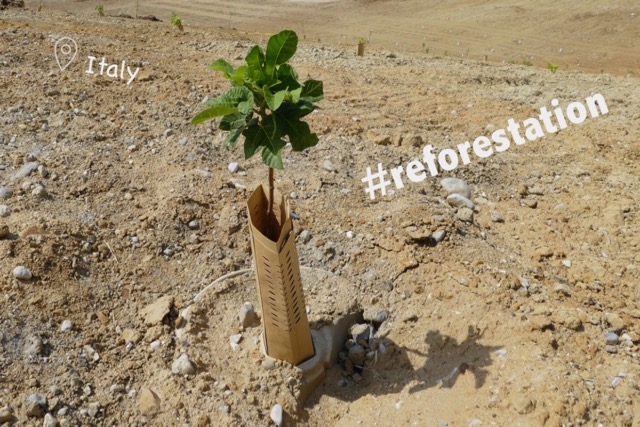
Reforestation helps to fight climate change, drought and fires. Innovations like the COCOON support young trees and accelerate the creation of new forests.
Contributes to achieving the following UN Sustainable Development Goals:
As soon as our anchor is securely set in a Sicilian bay, we take a dive into the azure-blue and crystal clear water of the Mediterranean Sea. However, at 33°C it is hardly refreshing. For weeks, temperatures have been very high, even for South Italian standards. The high-pressure area that causes this extreme weather is so large and steadfast that it has been given a name: Lucifer. According to climate scientists, such hot and dry weather is likely to occur more frequently in the Mediterranean in the future.
A little later an airplane approaches, flying ever lower. Will it land on the water? No, it touches the water only to ascend again. It is an aircraft of the Italian fire brigade that uses our bay to collect water. In the distance we see the plane flying towards grey clouds of smoke. There is a wildfire on the island, one of many. It’s upsetting to see and we wonder if there is a solution that can help to fight climate change, drought and fires in a more structural way?
Innovation from Amsterdam
An Amsterdam-based company might play a major role in such a solution. Just before we left the Netherlands, we visited Land Life Company, which works towards ecosystem restoration through reforestation. Charlotte Jongejan, Head of Marketing & Communications explains that reforestation tackles several problems at once: “Trees store CO2 and are an important part of ecosystems. In addition, trees can be of economic value to a community.”
Charlotte emphasises that it is important to do it properly: “The trees must feel at home in the place where they are planted. That means that the soil conditions, the amount of sun and the availability of water should correspond to what the tree needs.” Once the right trees are chosen, it’s a matter of protecting the seedlings. They are very vulnerable, especially the first year, because their roots cannot reach the groundwater yet and animals can pose a threat. In order to increase the chances of survival, Land Life Company have developed the COCOON.
A Donut for Trees
Charlotte shows us a round container with a detachable lid. With a circular hole in the middle, it looks like a large donut. Charlotte senses our confusion and explains: “The COCOON is placed in the ground around the seedling. It is filled with water. A wick drip-feeds the seedling from the reservoir during the first 6-9 months. The lid prevents evaporation of the water. That way the seedling gets a good start”. A perforated tube which fits exactly in the hole surrounds the seedling to prevent animals from harming the young trees.
The COCOON and its lid are made of the same cardboard-like material. Charlotte pre-empts our next question. “After 6-9 months the roots of the tree will have developed sufficiently for the tree to survive without the COCOON. The COCOON is made of biodegradable material and dissolves into material that is nutritious for the tree.”
It sounds wonderful, but what are the experiences so far? “The main advantage is that in dry areas the survival rate of seedlings in their first year is increased from a meagre 10% to a whopping 80-90%.” As a result, fewer trees need to be purchased, transported and planted. In addition, water is saved. So, although the COCOON is an extra cost, using it can actually lead to cost savings.
Reforestation in Practice
Back to hot southern Italy. We would like to see how the COCOON works in practice. Charlotte informs us that we can visit a reforestation project in Calabria, not far from Sicily. On our way there we traverse hot and dry landscapes. How are the seedlings that were planted here half a year ago coping with these conditions?
At the site, project leader Antonella Totaro receives us on behalf of Land Life Company. The landowner is also there and shows us a piece of land that looks like a lunar surface. “In the past, the soil was excavated here for construction material,” the owner explains. Now he wants to make the land fertile again with native, fruit-bearing trees. And it seems to work! Virtually all fig, pomegranate and olive trees are healthy. With their fresh green leaves they defy the drought. Only a few seedlings have not made it and some lids have disappeared. “That’s normal,” Antonella assures us. She and the landowner are satisfied.
Scaling-up Ecosystem Restoration
The project in Calabria is part of The Green Link, a European reforestation program. It is a public-private partnership in which local landowners are involved alongside the EU. The goal is to make barren areas fertile all over Europe in order to generate income for the local communities and sequester CO2.
There are also a lot of reforestation initiatives outside Europe. During our short stay in the Netherlands two years after our departure, we visit Land Life Company again. Charlotte has invited us to the premiere of the documentary It Will Be Green Again. It depicts a refugee camp in Cameroon where the COCOON is used to reforest the land and provide the refugees with work and food. After the screening, we speak with Land Life Company’s founder and CEO Jurriaan Ruys. “We are growing fast. More and more organizations are recognizing the importance of reforestation. Ever-larger projects are being realized in more and more places around the world.” The COCOON itself has also been further improved, as we learn from the Head of Research & Development Harrie Lövenstein. “An important point of improvement is the shape of the lid. Rainwater is now being absorbed better and it is easier to weigh it up with earth or stones to prevent it from blowing away. “
A Logical Investment
Back on board we notice that we now look at trees differently. A forest is not only beautiful in itself, but also an ecosystem that provides important services to us. Trees store CO2 in their wood and in the soil. We can therefore reduce climate change by planting forests. Trees also regulate water, they absorb water when it rains and evaporate water during droughts. This keeps the soil healthy and the environment also becomes more humid.
“To me, planting more forest seems an excellent structural solution against wildfires such as in Sicily,” concludes Ivar. “I fully agree,” says Floris. “Looking at it this way, a forest also has a lot of economic value. So it makes a lot of sense to invest in reforestation”. And with innovations such as the COCOON, this can be done faster than ever.
Related Sustainable Solutions

Restoring Mangroves (VCT)
On Union Island, mangrove restoration has led to increased biodiversity, better coastal protection, and more economic activity.

Wildlife Rescue (SUR)
In Suriname, we meet an organization that rescues wildlife. How does that also help our own survival?

Sea Forests (NAM)
In South Africa and Namibia, we learn about the importance of current and future sea forests. How can they help humanity become more sustainable?

Coral Gardening (PYF)
In French Polynesia we see the beauty of coral reefs, but these important ecosystems are under threat. Fortunately, it’s not too late to save them.

Shark Protection (PYF)
French Polynesia is saving sharks with the largest shark sanctuary in the world. These top predators are vital in keeping reefs and oceans healthy.

A Farm That Restores Nature (CHL)
The Chilean farm Alihuen combines organic farming and tourist education to restore local flora and fauna on former grasslands.

Cleverly Fighting Plastic Pollution (CHL)
Chilean company Algramo uses clever, reusable packaging to reduce plastic waste and save customers money.

Investing in Nature (CHL)
Chilean Patagonia thanks its pristine wilderness to successful conservation efforts. Among them Tompkins Conservation, a remarkable, private initiative.

Artificial Reefs (CPV)
In Cape Verde and Brazil we learn how man-made structures can help to restore underwater ecosystems.

Saving Sea Turtles (CPV)
On the Cape Verdian island of Sal, we meet an organisation that saves sea turtles. We learn how biodiversity can be increased and damaged ecosystems restored while working together with the tourism industry.

Rewilding (GRC)
On the Greek island of Kalamos, we learn about rewilding. We are inspired by the way this form of ecosystem regeneration balances natural and human needs.

Reforestation on Steroids (ITA)
Reforestation helps to fight climate change, drought and fires. Innovations like the COCOON support young trees and accelerate the creation of new forests.

Creative with Cork (PRT)
In Portugal we learn all about the environmental and social sustainability aspects of cork. Time to get more creative with this remarkable natural material!
